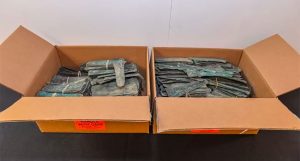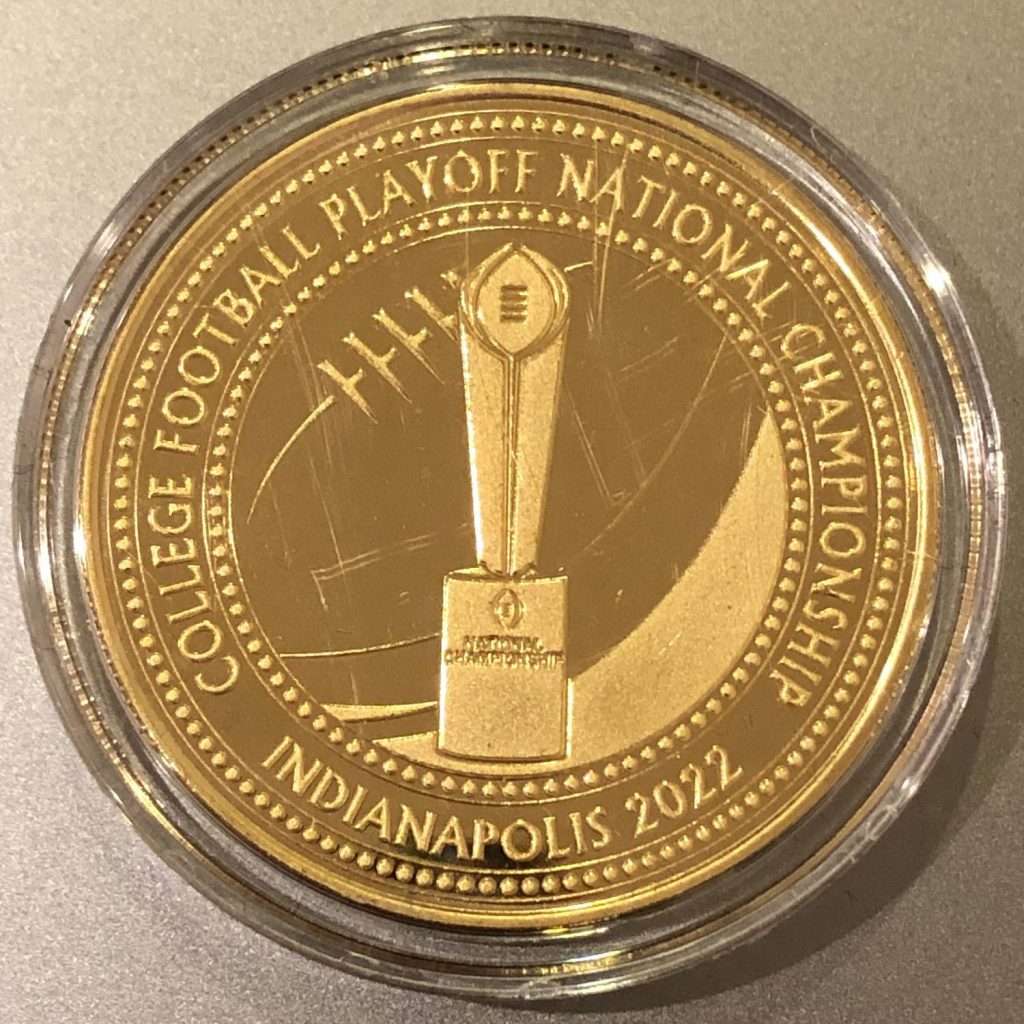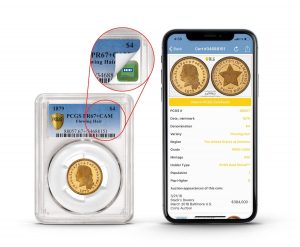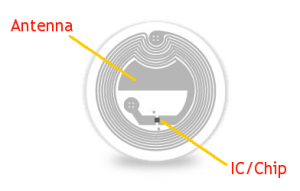A CHAMPIONSHIP COLLECTIBLE
I have not talked about my favorite news of January, and I waited until I received a numismatic collectible to go along with the news. In case you have not heard
After Georgia’s 33-18 victory over Alabama to capture our first National Championship in 41 years, my fingers sprinted to the Georgia Bookstore website to place a significant order. Included in my order was the obligatory numismatic item to add to my collection
Struck by the Highland Mint of Melbourne, Florida, I added the gold-plated medal to my collection next to my 2018 Rose Bowl victory commemorative medal.
The Highland Mint has limited production to 5,000 medals. It is a 39 mm gold-plated masterpiece that has me excited.
The Dawg Nation has been celebrating for the last three weeks. We are ecstatic and will continue to celebrate for the next few months. In the meantime, I may go to the Highland Mint’s website to see what else I can add to my collection. HOW BOUT THEM DAWGS!
Weekly World Numismatic News for January 19, 2020

Abbasid coins of the late ninth century
(via Egypt Today)
The Ottoman Empire was the last of the significant conquering empires of Europe. By the late 19th century, modernization and uprisings forced the Empire to consolidate around the area of modern-day Turkey and the Middle East. Even though the Empire was declining, that did not stop the government from trying to exert influence.
After Great Britain left Egypt in 1914, the Ottomans stepped in and demanded Egypt pay tribute in the form of gold coin to the Empire. After the fall of the Empire and the formation of modern-day Turkey, they continued to demand tribute. Egypt stopped paying the tribute on the establishment of the Republic in 1953.
The lawsuit claims that the Ottomans and Turkey illegally removed the coins from Egypt and demands their return.
In one report, the brief cites the provisions of the UNESCO convention as authority for demanding their return by declaring the coins as cultural property.
If allowed through their courts and if the suit is successful, it becomes precedent for Egypt to claim any item as cultural property and demand their return. Aside from coins, exhibits at museums around the world would have to prepare for similar requests. In the United States, the Brooklyn Museum has one of the most extensive Egyptology collection in North America. Their holding is second to the British Museum, who will also face the same questions.
Ancient Egypt did not have a monetary system as we know it today. Since they did not have silver mines and gold was scarce, they traded goods and services. Taxes were paid by people providing products or working for the government.
There are known bronze coins from early periods, but several references noted that they were used for a limited amount of trade.
The first known coins of Egypt came during the Ptolemaic Empire of ancient Greece. By that time, the Egyptian Empire moved up the Nile River from the area near modern Cairo to modern-day Alexandria. As a weakened Empire, Ptolemy I was able to conquer these areas of the Middle East following the death of Alexander the Great.
It was a time of great fortune that included education, the arts, and modernization of the old Egyptian Empire. Silver and gold were brought as the economy soared. Ptolemaic coins are considered Greek coins for many collectors of ancient coinage.
Those who enjoy collection ancient coins should carefully watch this case as it winds through the Egyptian courts. The wrong outcome will affect collectors and be another attack on the hobby.
And now the news…
 → Read more at frbatlanta.org
→ Read more at frbatlanta.org
 → Read more at romania-insider.com
→ Read more at romania-insider.com
 → Read more at ottawacitizen.com
→ Read more at ottawacitizen.com
 → Read more at cbc.ca
→ Read more at cbc.ca
 → Read more at cnn.com
→ Read more at cnn.com
 → Read more at egypttoday.com
→ Read more at egypttoday.com
 → Read more at dailyrecord.co.uk
→ Read more at dailyrecord.co.uk
Weekly World Numismatic News January 12, 2020
My story of the week comes from England, where a father, separated from the boy’s mother, lives 100 miles away from his son. To maintain their bond, the father and son collect coins.
Aside from using coins as their bond, the video notes that when they are together, the pair looks for coins in Britain’s version of thrift stores. Some of the stores are run by charitable organizations whose inventory relies on donations.
Jacob, 7, and his dad John are not hunting high-end coins. They are looking for interesting pieces, filling holes from pocket change, and anything else they can find. It is father and son time over a shared interest that each can do on their own and talk about later.
Watch the video below. Maybe it will give you an idea as to how to use coins to bond with your children.
And now the news…
 → Read more at rivertowns.net
→ Read more at rivertowns.net
 → Read more at krqe.com
→ Read more at krqe.com
 → Read more at thevintagenews.com
→ Read more at thevintagenews.com
 → Read more at buffalonews.com
→ Read more at buffalonews.com
 → Read more at bbc.com
→ Read more at bbc.com
 → Read more at mylondon.news
→ Read more at mylondon.news
 → Read more at kitco.com
→ Read more at kitco.com
 → Read more at abcnews.go.com
→ Read more at abcnews.go.com
Weekly World Numismatic News for January 5, 2020
News opened for the new year with ancient coins returning to Mexico after previously been legal for trade.

Pre-Hispanic Mexican coins that were recently “returned” to Mexico (Image courtesy of Mexico News Daily)
After the coins were taken to Spain for auction, the Mexican government contacted the FBI asking for their help. Allegedly, the collector voluntarily turned them over.
Even though the coins were obtained legally and subsequently legislated into chattel, foreign governments continue to attack United States collectors because they can.
Under the UNESCO convention, numismatic items are the most problematic. When so many examples exist, every coin should not be considered cultural property. Countries can be reasonable and hold back a few examples that would help tell their story, but what is wrong with sharing that story with the world? Does 3,500 coins, most that will never see the light of day again, have to be hidden from the public in Mexico? Would it be against Mexico’s interest to share about 85-percent of that hoard with the world?
Watchers of how countries selectively enforce the provisions UNESCO convention will note that the majority of claims on the alleged numismatic cultural property occurs in the United States or against Americans abroad. Why does the Italian government not claim property rights for all the Roman hoards found in the United Kingdom? Why has there not been claims made against hoards found along the path of the Silk Road during the last few decades?
The only time the UNESCO convention is invoked for numismatics is when someone tries to smuggle coins out their countries, which is reasonable, or in the United States. Why?
And now the news…
 → Read more at mexiconewsdaily.com
→ Read more at mexiconewsdaily.com
 → Read more at breakingisraelnews.com
→ Read more at breakingisraelnews.com
 → Read more at haaretz.com
→ Read more at haaretz.com
 → Read more at bnn-news.com
→ Read more at bnn-news.com
 → Read more at whig.com
→ Read more at whig.com
Weekly World Numismatic News for December 29, 2019
Coin World wants to join the sticker craze and add one to your NGC or PCGS slabbed coin. PCGS is offering a similar technology under the label.
Both services will use something called Near Field Communication (NFC). NFC is a technology based on low-frequency communications where a transmitter emits a signal when activated by a reader.
Although NFC is not a new technology, it had gained interest when Apple announced that the latest iPhones had programmable NFC hardware. The NFC capabilities built into prior versions of the iPhone were not accessible outside of Apple’s applications running on the phone.
You may have used NFC without your knowledge. All contactless payments like Apple Pay, Google Pay, and the tap-to-pay credit cards require NFC. Many department stores are using they call smart tags, which are tags with an NFC chip embedded in them. Aside from electronic payment, contactless keycards, sometimes called proximity cards, are used to access restricted areas are NFC-based technologies.
Now Coin World and PCGS want to bring it to numismatics.Like every technology, NFC is not perfect. Its most significant risks come from the use of NFC tags. These low-power devices have limitations that have allowed hackers to defeat whatever features they are supposed to protect.
The security concerns do not consider privacy issues. Do you trust PCGS or Coin World with the data they claim to be keeping? Do you trust that this data will not be for sale under any circumstances? Do you trust that there are sufficient protections in place to prevent others from hacking the NFC antenna that will allow you to be tracked?
In my past life in information security, I had the opportunity to test the security of these wireless communications. As part of the test, I was able to walk out into the parking lot and open car doors without access to the keys. Unfortunately, the principles I used in that demonstration are the same that others have used to hack NFC.
As we head into 2020, I plan to discuss the impact of NFC from the perspective of someone who used to look at this stuff for a living and had to explain it to non-technical people.
And now the news…
 → Read more at ottawacitizen.com
→ Read more at ottawacitizen.com
 → Read more at taiwannews.com.tw
→ Read more at taiwannews.com.tw
 → Read more at krqe.com
→ Read more at krqe.com
 → Read more at myjoyonline.com
→ Read more at myjoyonline.com
 → Read more at newsmax.com
→ Read more at newsmax.com
 → Read more at anash.org
→ Read more at anash.org
 → Read more at djournal.com
→ Read more at djournal.com
HAPPY HOLIDAYS!
May the holidays find you happy, hopeful, and healthy.
Since I missed posting the news from Sunday: and now the news…
 → Read more at securingindustry.com
→ Read more at securingindustry.com
 → Read more at baltimorepostexaminer.com
→ Read more at baltimorepostexaminer.com
 → Read more at bbc.com
→ Read more at bbc.com
 → Read more at forbes.com
→ Read more at forbes.com
 → Read more at dailymail.co.uk
→ Read more at dailymail.co.uk






 As we celebrate the holidays and the new year, I hope we can remember those less fortunate who might need our help. Helping a neighbor is the best gift we can give and a sign of love beyond measure.
As we celebrate the holidays and the new year, I hope we can remember those less fortunate who might need our help. Helping a neighbor is the best gift we can give and a sign of love beyond measure.